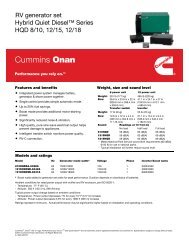Air Brake Manual
Air Brake Manual
Air Brake Manual
Create successful ePaper yourself
Turn your PDF publications into a flip-book with our unique Google optimized e-Paper software.
<strong>Air</strong> Pressure Gauge<br />
Vehicles with an air brake system are equipped with<br />
a reservoir air pressure gauge (29). This gauge is<br />
mounted in the cab, usually on the dashboard and<br />
indicates the air pressure in the primary and<br />
secondary or dry reservoirs. The supply or wet<br />
reservoir does not usually have an air pressure<br />
gauge. Common operating pressures are 80 to 135<br />
psi, depending on the system. Monitoring the gauge<br />
will alert the driver to any unusual changes in air<br />
pressure.<br />
<strong>Brake</strong> Application Gauge<br />
An additional gauge can be installed on the dash to<br />
indicate the application air pressure when the<br />
brakes are applied. This gauge can be piped to<br />
indicate the pressure of either a foot or hand<br />
application. (Hand application will be explained later<br />
in the manual.)<br />
Low Pressure Warning Device<br />
All vehicles equipped with an air brake system must<br />
have a device to warn the driver if the air pressure in<br />
the system drops to a dangerous level. This device<br />
must be comprised of two systems - visual and audible<br />
- consisting of a red warning light and a buzzer or a<br />
wig wag. Due to overuse or leaks, the low pressure<br />
indicator switch (9) will turn on a red warning light on<br />
the dash or cause a buzzer to sound at or before 55<br />
psi. Some vehicles are equipped with both a light and<br />
a buzzer to warn the driver of a low air pressure<br />
condition.<br />
Wig-wags are not found in modern vehicles having<br />
been replaced with a red warning light and buzzer.<br />
They may still be in use on older vehicles. There are<br />
two types of wig-wag low pressure warning devices<br />
that may be used. Both types will drop into the driver’s<br />
view should the system pressure drop to 55 psi. The<br />
automatic warning device will rise out of the driver’s<br />
view when the pressure in the system rises above 55<br />
psi. The manual reset type must be placed in the “out<br />
of view” position manually and will not stay in place<br />
until the pressure in the system goes above 55 psi.<br />
Whichever warning system is used, buzzer-lights or<br />
wig-wag, the driver must stop the vehicle and find the<br />
cause of the air loss. The air pressure remaining in the<br />
system (approximately 55 psi) is enough for a brake<br />
application if the driver acts promptly.<br />
Stop Light Switch<br />
Any driver following your vehicle must be warned<br />
when reducing speed or stopping the vehicle. The stop<br />
light switch (25) is an air-operated electric switch that<br />
turns on the brake lights at the rear of the vehicle<br />
when a brake application is being made.<br />
27




